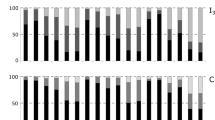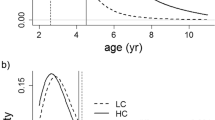Abstract
Teeth are vital for mammal performance and especially in ungulates relying on mechanical decomposition of plant material for effective microbial digestion and energy uptake. The main focus of the role of teeth in ungulate life histories has been on tooth wear, while no one has addressed to what extent deviation from the natural set of teeth (maldentition) causes variation in individual fitness components. Based on mandibles from 41,066 individual red deer (Cervus elaphus L.) collected from 1969 to 2001, we tested whether maldentition had an effect on individual body condition and whether this effect depended on environmental harshness. Females with maldentition (0.6% of the population) were in a poorer condition than individuals without tooth anomalies and the effect increased during unfavorable climatic conditions. The effect of maldentition in males was less clear. This study indicates that a well-functioning set of teeth is essential for mammal performance, and that selection pressure against (dental) anomalies is more pronounced when climate is unfavorable.


Similar content being viewed by others
References
Agresti A (1990) Categorical data analysis. Wiley, New York
Ahlén I (1965) Studies on the red deer, Cervus elaphus L., in Scandinavia. Swed Wildl Res 3:177–376
Ahlén I (1975) Winter habitats of moose and deer in relation to land use in Scandinavia. Swed Wildl Res 9:45–192
Akaike H (1974) A new look at statistical model identification. IEEE T Automat Contr AU 19:716–722
Azorit C, Munõs-Cobo J, Analla M (2002) Abnormal teeth in the Spanish red deer. Z Jagdwiss 48:252–260
Buckland ST, Burnham KP, Augustin NH (1997) Model selection: an integral part of inference. Biometrics 53:603–618
Burnham KP, Anderson DR (1998) Model selection and inference: a practical information-theoretic approach. Springer, Berlin Heidelberg New York
Conner MM, White GC, Freddy DJ (2001) Elk movement in response to early-season hunting in northwest Colorado. J Wildl Manage 65:926–940
Coulson T, Milner-Gulland EJ, Clutton-Brock T (2000) The relative roles of density and climatic variation on population dynamics and fecundity rates in three contrasting ungulate species. Proc R Soc Lond Ser B 267:1771–1779
Efron B, Tibshirani RJ (1993) An introduction to the bootstrap. Chapman and Hall, London
Ericsson G, Wallin K (2001) Age-specific moose (Alces alces) mortality in a predator-free environment: Evidence for senescence in females. Ecoscience 8:157–163
Firth D (1993) Bias reduction of maximum likelihood estimates. Biometrika 80:27–38
Gaillard J-M, Delorme D, Boutin J-M, Van Laere G, Pradel R (1993) Roe deer survival patterns: a comparative analysis of contrasting populations. J Anim Ecol 62:778–791
Garrott RA, Eberhardt LL, Otton JK, White PJ, Chaffee MA (2002) A geochemical trophic cascade in Yellowstone’s geothermal environments. Ecosystems 5:659–666
Gordon IJ, Illius AW (1988) Incisor arcade structure and diet selection in ruminants. Funct Ecol 2:15–22
Hallett TB, Coulson T, Pilkington JG, Clutton-Brock TH, Pemberton JM, Grenfell BT (2004) Why large-scale climate indices seem to predict ecological processes better than local weather. Nature 430:71–75
Heinze G, Schemper M (2002) A solution to the problem of separation in logistic regression. Stat Med 21:2409–2419
Hurrell JW, Van Loon H (1997) Decadal variations in climate associated with the North Atlantic Oscillation. Clim Change 36:310–326
Johnson JB, Omland KS (2004) Model selection in ecology and evolution. Trends Ecol Evol 19:101–108
Kierdorf U, Kierdorf H (2002) Supernumerary incisiform tooth in a red deer. Z Jagdwiss 48:276–280
King G, Zeng L (2001) Explaining rare events in international relations. Int Organ 55:693–715
Klein DR, Olson ST (1960) Natural mortality pattern of deer in southeast Alaska. J Wildl Manage 24:80–88
Kratochvil Z (1984) Verandrungen am Gebiss des Rehwildes (Capreolus capreolus L.). Folia Zool 83:209–222
Langvatn R (1977) Criteria of physical condition, growth and development in Cervidae,—suitable for routine studies. Nordic Council for Wildlife Research, Stockholm
Langvatn R, Loison A (1999) Consequences of harvest on age structure, sex ratio and population dynamics of red deer in central Norway. Wildl Biol 5:213–223
Langvatn R, Albon SD, Burkey T, Clutton-Brock TH (1996) Climate, plant phenology and variation in age at first reproduction in a temperate herbivore. J Anim Ecol 65:653–670
Langvatn R, Mysterud A, Stenseth NC, Yoccoz NG (2004) Timing and synchrony of ovulation in red deer constrained by short northern summers. Am Nat 163:763–772
Loe LE, Mysterud A, Langvatn R, Stenseth NC (2003) Decelerating and sex-dependent tooth wear in Norwegian red deer. Oecologia 135:346–353
Loe LE, Meisingset E, Mysterud A, Langvatn R, Stenseth NC (2004) Phenotypic and environmental correlates of tooth eruption in red deer (Cervus elaphus). J Zool 262:83–89
McCullagh P, Nelder JA (1989) Generalized linear models. Chapman and Hall, London
Mitchell B (1967) Growth layers in dental cement for determining the age of red deer (Cervus elaphus L.). J Anim Ecol 36:279–293
Mysterud A, Yoccoz NG, Stenseth NC, Langvatn R (2000) Relationships between sex ratio, climate and density in red deer: the importance of spatial scale. J Anim Ecol 69:959–974
Mysterud A, Langvatn R, Yoccoz NG, Stenseth NC (2001a) Plant phenology, migration and geographic variation in body weight of a large herbivore: the effect of a variable topography. J Anim Ecol 70:915–923
Mysterud A, Stenseth NC, Yoccoz NG, Langvatn R, Steinheim G (2001b) Nonlinear effects of large-scale climatic variability on wild and domestic herbivores. Nature 410:1096–1099
Mysterud A, Yoccoz NG, Stenseth NC, Langvatn R (2001c) The effects of age, sex and density on body weight of Norwegian red deer: evidence of density-dependent senescence. Proc R Soc Lond Ser B 268:911–919
Pérez-Barbería FJ, Gordon IJ (1998) Factors affecting food communution during chewing in ruminants: a review. Biol J Linnean Soc 63:233–256
R Development Core Team (2004) R: a language and environment for statistical computing. R Foundation for Statistical Computing, Vienna, Austria
Reimers E, Nordby Ø (1968) Relationships between age and tooth cementum layers in Norwegian reindeer. J Wildl Manage 32:957–961
Skogland T (1988) Tooth wear by food limitation and its life history consequences in wild reindeer. Oikos 51:238–242
Venables WN, Ripley BD (1999) Modern Applied Statistics with S-plus. Springer, Berlin Heidelberg New York
Yoccoz NG, Mysterud A, Langvatn R, Stenseth NC (2002) Density-dependent and age related reproductive effort in male red deer. Proc R Soc Lond Ser B 269:1523–1528
Zima J (1988) Incidence of dental anomalies in Capreolus capreolus from Czechoslovakia. Folia Zool 37:129–144
Acknowledgements
We gratefully acknowledge the financial support provided by the AURORA grant from the Research Council of Norway (NFR) and EGIDE (French Ministry for Foreign Affairs) to L.E.L and C.B. We thank David Firth, Nigel G. Yoccoz, Torbjørn Ergon, and Jon Olav Vik for valuable statistical advice, and Jean-Michel Gaillard and the two anonymous referees for valuable comments on an earlier draft. We declare that no action associated with this work violates the current laws of Norway.
Author information
Authors and Affiliations
Corresponding author
Electronic supplementary material
Rights and permissions
About this article
Cite this article
Loe, L.E., Bonenfant, C., Langvatn, R. et al. Increased effect of harsh climate in red deer with a poor set of teeth. Oecologia 147, 24–30 (2006). https://doi.org/10.1007/s00442-005-0172-7
Received:
Accepted:
Published:
Issue Date:
DOI: https://doi.org/10.1007/s00442-005-0172-7




